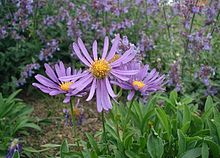Aster (genus): Difference between revisions
m remove link ja |
|||
| Line 91: | Line 91: | ||
[[Category:Garden plants]] |
[[Category:Garden plants]] |
||
[[Category:Flowers]] |
[[Category:Flowers]] |
||
[[ja:シオン (植物)]] |
|||
Revision as of 07:17, 2 November 2013
- For other uses, see Aster (disambiguation).
| Aster | |
|---|---|

| |
| Aster amellus | |
| Scientific classification | |
| Kingdom: | |
| (unranked): | |
| (unranked): | |
| (unranked): | |
| Order: | |
| Family: | |
| Tribe: | |
| Genus: | Aster |
| Type species | |
| Aster amellus | |
| Synonyms [2] | |
| |
Aster is a genus of flowering plants in the family Asteraceae. Its circumscription has been narrowed, and it now encompasses around 180 species, all but one of which are restricted to Eurasia; many species formerly in Aster are now in other genera of the tribe Astereae.
Circumscription
The genus Aster once contained nearly 600 species in Eurasia and North America, but after morphologic and molecular research on the genus during the 1990s, it was decided that the North American species are better treated in a series of other related genera. After this split there are roughly 180 species within the genus, all but one being confined to Eurasia.[3] The name Aster comes from the Ancient Greek word ἀστήρ (astér), meaning "star", referring to the shape of the flower head. Many species and a variety of hybrids and varieties are popular as garden plants because of their attractive and colourful flowers. Aster species are used as food plants by the larvae of a number of Lepidoptera species—see list of Lepidoptera that feed on Aster. Asters can grow in all hardiness zones.
The genus Aster is now generally restricted to the Old World species, with Aster amellus being the type species of the genus, as well as of the family Asteraceae.[1] The New World species have now been reclassified in the genera Almutaster, Canadanthus, Doellingeria, Eucephalus, Eurybia, Ionactis, Oligoneuron, Oreostemma, Sericocarpus and Symphyotrichum, though all are treated within the tribe Astereae. Regardless of the taxonomic change, all are still widely referred to as "asters" (popularly "Michaelmas daisies" because of their typical blooming period) in the horticultural trades. See the List of Aster synonyms for more information.
Some common North American species that have now been moved are:
- Aster breweri (now Eucephalus breweri), Brewer's aster
- Aster cordifolius (now Symphyotrichum cordifolium), blue wood aster
- Aster dumosus (now Symphyotrichum dumosum), New York aster
- Aster divaricatus (now Eurybia divaricata), white wood aster
- Aster ericoides (now Symphyotrichum ericoides), heath aster
- Aster laevis (now Symphyotrichum laeve), smooth aster
- Aster lateriflorus (now Symphyotrichum lateriflorum), "Lady in Black", calico aster
- Aster novae-angliae (now Symphyotrichum novae-angliae), New England aster
- Aster novi-belgii (now Symphyotrichum novi-belgii), New York aster
- Aster peirsonii (now Oreostemma peirsonii), Peirson's aster
- Aster protoflorian (now Symphyotrichum pilosum), frost aster
- Aster scopulorum (now Ionactis alpina), lava aster
- Aster sibiricus (now Eurybia sibirica), Siberian aster
The "China aster" is in the related genus Callistephus.
Species

In the United Kingdom, there are only two native members of the genus: goldilocks, which is very rare, and Aster tripolium, the sea aster. Aster alpinus spp. vierhapperi is the only species native to North America.[2]
Some common species are:
- Aster alpinus, Alpine aster
- Aster amellus, European Michaelmas daisy or Italian aster
- Aster linosyris, goldilocks aster
- Aster scaber
- Aster tataricus, Tatarian aster
- Aster tongolensis
- Aster tripolium, sea aster
Hybrids and cultivars
(those marked agm have gained the Royal Horticultural Society's Award of Garden Merit:-
- Aster × frikartii (A. amellus × A. thomsonii) Frikart's aster[4]
- 'Kylie' (A. novae-angliae 'Andenken an Alma Pötschke' × A. ericoides 'White heather')[7]
- 'Ochtendgloren'agm[8] (A. pringlei hybrid)
- 'Photograph'agm[9]
In human culture
The Hungarian revolution of 31 October 1918, became known as the "Aster Revolution" due to protesters in Budapest wearing this flower.[10]
References
- ^ a b Elizabeth Pennissi (2001). "Linnaeus's last stand?". Science. 291 (5512): 2304–2307. doi:10.1126/science.291.5512.2304. PMID 11269295.
- ^ a b Luc Brouillet. "Aster Linnaeus, Sp. Pl. 2 : 872. 1753; Gen. Pl. ed. 5, 373. 1754". p. 20 http://www.efloras.org/florataxon.aspx?flora_id=1&taxon_id=102902.
{{cite book}}: Missing or empty|title=(help) in Flora of North America. - ^ Luc Brouillet, Theodore M. Barkley & John L. Strother. "Asteraceae Martinov tribe Astereae Cassini, J. Phys. Chim. Hist. Nat. Arts. 88: 195. 1819". p. 3 http://www.efloras.org/florataxon.aspx?flora_id=1&taxon_id=20538.
{{cite book}}: Missing or empty|title=(help) in Flora of North America. - ^ Floridata: Aster × frikartii
- ^ "RHS Plant Selector - Aster × frikartii 'Mönch". Retrieved 15 July 2013.
- ^ "RHS Plant Selector - A. × frikartii 'Wunder von Stäfa'". Retrieved 15 July 2013.
- ^ Klein, Carol. "Blazin' squad". Telegraph. Retrieved 15 July 2013.
- ^ "RHS Plant Selector - Aster 'Ochtendgloren'". Retrieved 15 July 2013.
- ^ "RHS Plant Selector - Aster 'Photograph'". Retrieved 15 July 2013.
- ^ Hajdu, Tibor (1990). "Revolution, Counterrevolution, Consolidation". In Peter F. Sugar (ed.). A History of Hungary ([New printing]. ed.). Bloomington: Indiana University Press. p. 297. ISBN 0253355788.
Bibliography
- Flora of North America Editorial Committee, ed. (2006). Magnoliophyta: Asteridae, Part 7: Asteraceae, Part 2. Flora of North America. Vol. 20. Oxford University Press. ISBN 9780195305647.
External links
- "Aster". Plantarium (in Russian).
- Ontario Wildflowers website Lots of info about Asters
- Pictures of Aster flowers thriving in the autumn sunshine
